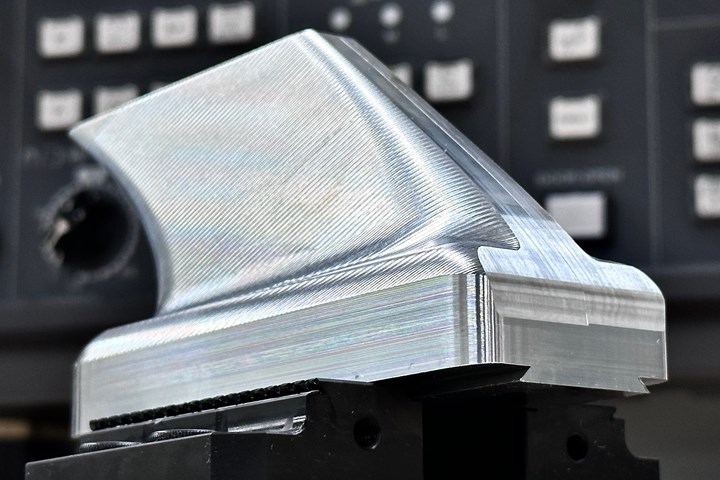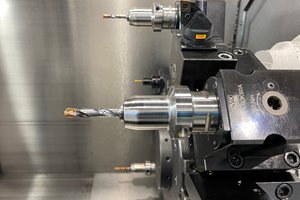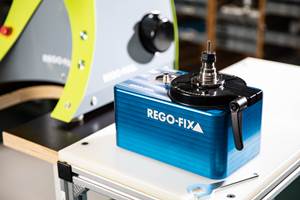Custom Workholding Principles to Live By
Workholding solutions can take on infinite forms and all would be correct to some degree. Follow these tips to help optimize custom workholding solutions.
Share




Reader Question:
We’re receiving a lot of orders where a custom workholding solution is required. Some ideas have worked, but others required more trial and error. Do you have some ideas to help us develop more effective solutions when a vise or soft jaw simply won’t work?
Regardless of the material, shape or tolerance of the part, there are some basic tenets every good workholding solution should follow.
First, the fixture should be easy for the operator to load, and difficult for them to load incorrectly. We want to set up a scenario where the operator can be as successful as possible. This means a consistent quality grip on the part, and possibly doing so quickly in a production scenario. Things like poka-yokes are important for proper part orientation and should be used. Do your best to make them clever and simple. It should not be an excessive burden to the operator where they may feel compelled to bypass them.
Second, the fixture is designed with the part print in mind, but also optimized to reduce the number of set ups. Ideally, every fixture will use fixed locators of some type for critical datums to rest against. This ensures mechanical repeatability for positional tolerances. Realistically though, this can sometimes force us into more operations. Therefore, use hard datums if you can, but use the machine probe or an in-process tolerance as needed to reduce part handling and still maintain tolerances.
Lastly, the clamping should be strong enough for roughing operations, but also limit distortion imparted on the part. You should be thinking about how clamping forces will impact the part as a raw billet, and when it is finished and weaker. The challenge is to clamp the part where it is strong and with enough force that it doesn’t move away from critical datums during heavy roughing, while also soft enough that it won’t distort the geometry of the weaker, finished part.
Sticking to these tenets will greatly improve custom workholding success, but they are not actual solutions, they are simply rules to live by. The actual workholding solution can take on infinite forms and all would be correct to some degree. Therefore, without seeing your specific parts, here are some ideas I would consider as you work on your designs or improve upon them:
The most obvious is modulating how much force you use to clamp the part. If the part is at risk of movement, consider more clamping force. If it is at risk of distortion, do the opposite. This could be using a torque wrench to limit the holding force of each clamp and create consistency from operator to operator. It can also mean that multiple clamps on the same part don’t necessarily need to hold the part with the same force. If you can get a better grip on the part in a stronger area, take it and limit the amount of force on a weaker area.
Consider the shape that we touch the part with. This applies to the clamp and the locator. This could be a point load or spread over a wider area. A smaller clamp point load may penetrate the surface of a softer metal and then provide some mechanical locking on the part. Or, if you’re trying to reduce deformation, consider a wider surface to reduce localized distortion. In either case, the same overall clamping force can yield very different results.
Equally important is the direction that we apply the force. Ideally, all forces should be pushing into a hard stop of some type. But if you are concerned about the part lifting, you could take a sideload and instead come from the top or an angled force to equally push and trap the part.
Often, workholding is smooth metal on smooth metal and no matter the amount of force, a part can still slide. This is where friction can be your friend. This can be done with grip tape, laser texture or a serrated clamp. In each case, we increase the effective holding force with the same amount of clamping force. Distortion is not increased, but part movement during machining is greatly reduced.
If you believe you’ve optimized all the above as best you can, but are still struggling, there are two troubleshooting techniques I like to use when diagnosing a fixture issue. First is putting a dial indicator on the part and watching its movement in critical areas during the clamping process. The movement could be shift in the part as it nests itself into the fixture, or it could be distortion imparted by the clamping forces or direction. Second is utilizing the machine probe to track movement of the part throughout the machining process. You can set up a quick positional check of a known feature at the beginning of the process, then after the bulk of the roughing. Based on the results, if you believe there to be part movement, you can then get more granular and run the same check tool by tool to find the culprit and adjust the magnitude of the forces (feed, depth of cut) or the direction of the forces (into hard locators versus away) as needed.
Custom workholding is not ideal for most job shops simply because of the cost and time and risk involved to develop a solution for such a small number of parts. Even in very high-volume production, a custom solution is necessary, but costly and risky as there’s only one chance to get it right. In either case, the best chance for success and mitigating risks is a well thought out plan. Follow the tenets, be creative and be ready for some troubleshooting for the highest chance of success.
Related Content
Form Tapping Improves Tool Life, Costs
Moving from cut tapping to form tapping for a notable application cut tooling costs at Siemens Energy and increased tool life a hundredfold.
Read MoreFive Common Mistakes Shops Make with ER Collets (And How to Prevent Them)
Collets play a crucial role in the machining process, so proper tool assembly and maintenance is important. Here are five potential pitfalls to avoid when using ER collets.
Read MoreQuick-Change Tool Heads Reduce Setup on Swiss-Type Turning Centers
This new quick-change tooling system enables shops to get more production from their Swiss turning centers through reduced tool setup time and matches the performance of a solid tool.
Read MoreOrthopedic Event Discusses Manufacturing Strategies
At the seminar, representatives from multiple companies discussed strategies for making orthopedic devices accurately and efficiently.
Read MoreRead Next
5 Rules of Thumb for Buying CNC Machine Tools
Use these tips to carefully plan your machine tool purchases and to avoid regretting your decision later.
Read MoreRegistration Now Open for the Precision Machining Technology Show (PMTS) 2025
The precision machining industry’s premier event returns to Cleveland, OH, April 1-3.
Read MoreSetting Up the Building Blocks for a Digital Factory
Woodward Inc. spent over a year developing an API to connect machines to its digital factory. Caron Engineering’s MiConnect has cut most of this process while also granting the shop greater access to machine information.
Read More
































